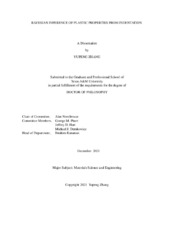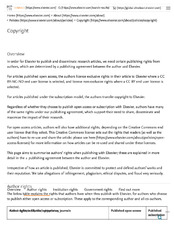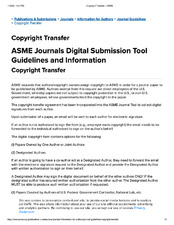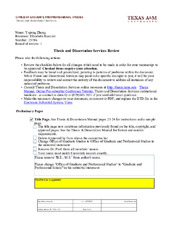| dc.description.abstract | This dissertation concerns the relation between the response of materials in an indentation test and their inelastic mechanical properties. The connection between indentation responses and inelastic properties is not straightforward and may not be unique. A Bayesian-type statistical approach is developed to overcome this difficulty. In this approach, a finite subset of the possible parameter space is considered since the range of physically possible parameter values is known. Finite element indentation calculations are carried out for a relatively coarse grid of discrete property values. Interpolation of indentation responses is used to obtain predictions for material property values between grid points. A uniform initial probability is assigned to each prediction. This overcomes the disadvantage typically associated with using Bayesian statistics of a large number of calculated responses being needed for what is in principle an infinite parameter space. Various elastic-plastic constitutive descriptions have been considered including rate-independent isotropically hardening plastic materials, plastically compressible materials and power-law creep materials. In all cases computed, synthetic "experimental" indentation responses are used for the parameter identification. In order to overcome the non-uniqueness associated with identification based on using only the indentation force versus indentation depth response, the surface profile after unloading is taken to be an additional "measured" quantity. Both noise-free and noise-contaminated data is considered.
We start by considering conical indentation of a rate-independent isotropically hardening solid with power-law strain hardening. It is known that materials with very different uniaxial responses can give indistinguishable indentation force versus indentation depth responses. Three sets of values of flow strength and strain hardening exponent are considered that give indistinguishable indentation force versus indentation depth responses. The proposed Bayesian-type statistical approach, by additionally taking account of residual surface profiles, provides a good estimate of the uniaxial stress-strain response for all three materials, both in the absence of fluctuations and in the presence of sufficiently small fluctuations. It is found that the sensitivity of the representation of the predicted uniaxial stress-strain response to fluctuations increases with increasing strain hardening.
Subsequently, motivated by the fact that the form of strain hardening relation that gives the best fit for a material is usually not known a priori, we study the influence of assumed strain hardening relations on plastic stress-strain response identification. We consider four power-law expressions as characterizations of the plastic uniaxial stress-strain response. Each expression is characterized by two material parameters, an initial flow strength and a strain hardening exponent. We found that each expression can provide a good representation of the same uniaxial stress-strain response but with different parameter values. The results obtained show that the identification of the hardening relation parameters and the associated uniaxial stress-strain response is not very sensitive to the form of the power-law strain hardening relation chosen even with data that has significant noise.
We then consider plastically compressible materials that are characterized by three material parameters. The "experimental" spherical indentation responses are obtained using two sets of parameter values that characterize the uniaxial responses of two real materials. We assume the materials can be characterized by a Deshpende-Fleck constitutive relation. The uniaxial stress-strain responses obtained by the Bayesian-type statistical approach provide good approximations of those of the "experimental" input materials, but the quality of the approximation decreases with increasing noise amplitude. The indentation force versus indentation depth responses with very different uniaxial stress-strain curves is found to be indistinguishable if the indentation depth is sufficiently small but are distinguishable if the indentation depth is sufficiently large. Plastic compressibility is found to have a relatively small effect on the correction factor in the Oliver-Pharr relation between the unloading slope and the effective (or reduced) elastic modulus. It is also found that the indentation response of these plastically compressible materials can be well-represented by a nearly incompressible plastic constitutive relation but that the inferred uniaxial stress-strain response is a poor representation of the "experimental" material uniaxial stress-strain response.
For materials that exhibit strong time and rate dependence, i.e. creep, the indentation depth versus time response is measured rather than the indentation force versus indentation depth. We consider power-law creep materials where the inelastic response is apparently characterized by two parameters, a creep exponent and a pre-exponential factor. However, the dimensions of the pre-exponential factor depend on the value of the creep exponent and comparing responses of different power-law creep materials requires consideration of three parameters, the creep exponent, a representative stress and a representative strain rate. Constant load and hold indentation creep tests are simulated for parameter values representative of three real materials. Uniaxial creep and uniaxial stress relaxation responses using the identified creep parameters from the Bayesian-type statistical approach were found to provide a very good approximation to the "experimental" responses for a sufficiently small values of creep exponent but a less good agreement for the largest value of creep exponent considered. The sensitivity to noise also increases with increasing stress exponent. The uniaxial creep response is found to be more sensitive to the accuracy of the predictions than the uniaxial stress relaxation response. As for time independent materials, the sensitivity to noise also increases with increasing stress exponent. The uniaxial creep response is found to be more sensitive to the accuracy of the predictions than the uniaxial stress relaxation response. A good agreement with the indentation response does not guarantee good agreement with the uniaxial responses. Comparison of the Bayesian-type statistical predictions for parameter values with the analytical models is carried out.
The Bayesian statistics formulation here used to relate indentation measurements to material properties has heuristic aspects. In order to provide a framework for relating that approach to a more rigorous Bayesian formulation for material property identification from experimental measurements, a Bayesian formulation with a normal likelihood quantifying noise and an inverse gamma prior expressing uncertainty about noise variance is derived. Using both analyses and numerical simulations, we show that the Bayesian-type statistical approach used in the studies of this thesis is a limiting form of the more rigorous formulation, with recommended prior parameter values of the rigorous Bayesian formulation. The results also show that the posterior probabilities are insensitive to the choice of prior mode when the prior's shape parameter is taken to be small. With consideration of bias in measured signals especially when multiple signal types are analyzed simultaneously, a method using a weighted average of posterior distributions from different signal types is proposed. This method is compared with a classical Bayesian approach that uses a joint likelihood. | |






